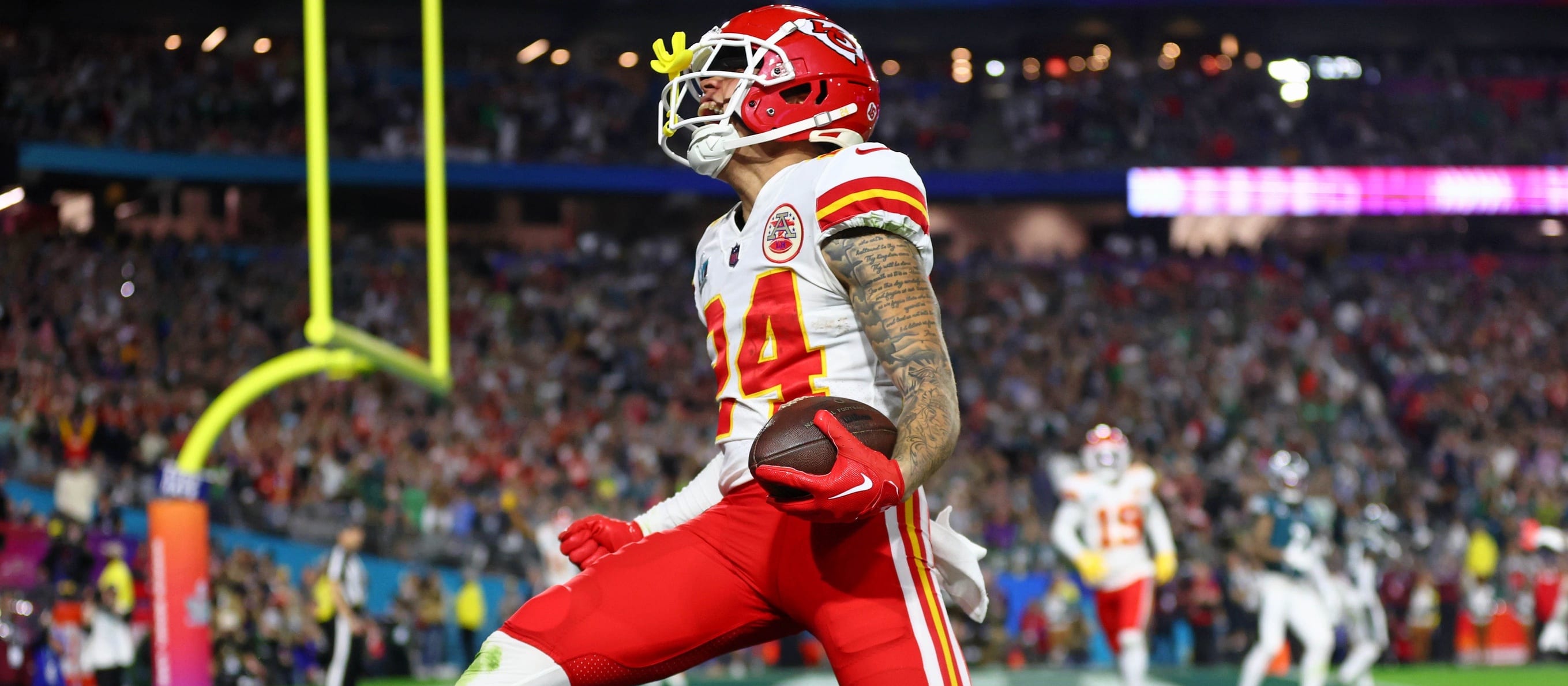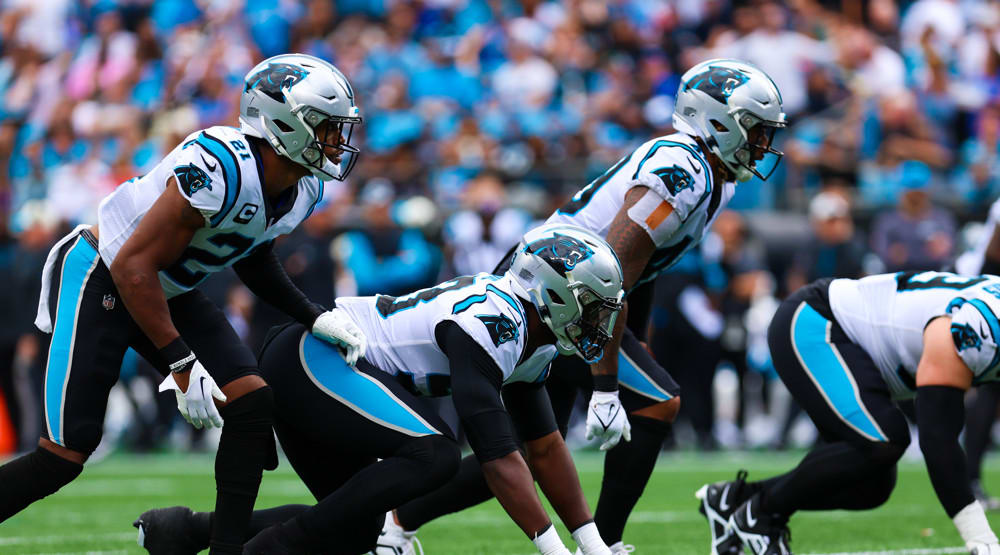This article is looking at some of the ongoing depth chart questions around the league at wide receiver and tight end. Each blurb looks at the candidates competing for a given role, with the presumed underdogs listed in strikethrough text.
The WR groups addressed include: Arizona, Buffalo, Carolina, Houston, Kansas City, the Rams and Tampa Bay. The TE groups addressed are Arizona, Green Bay and Las Vegas.
WIDE RECEIVER
Rondale Moore vs. Michael Wilson vs. Greg Dortch vs. Zach Pascal, ARI
Though the quarterback play might be of poor quality, there should be plenty of targets to go around in the Arizona offense as the Cardinals presumably get to losing in a hurry most weeks. Anticipating the exact personnel tendencies for the Arizona offense through those scenarios isn't the easiest thing, but at least it's easy to tell who these players are. What happens next depends on the strategic priorities of Arizona's coaches.
The more the Cardinals stick with the run game the more it means snaps for Michael Wilson and Zach Pascal, both of whom stand out among the Cardinals wideouts for their build. Whereas the other 3/5 of the top five are tiny, Wilson (6-foot-2, 213 pounds) and Pascal (6-foot-2, 218 pounds) are both bigger receivers. If you're serious about running the ball, you need some receivers of that build type on the field most of the time. Particularly in formations with wider splits (the wider the splits the closer to the sideline the boundary receiver
This article is looking at some of the ongoing depth chart questions around the league at wide receiver and tight end. Each blurb looks at the candidates competing for a given role, with the presumed underdogs listed in strikethrough text.
The WR groups addressed include: Arizona, Buffalo, Carolina, Houston, Kansas City, the Rams and Tampa Bay. The TE groups addressed are Arizona, Green Bay and Las Vegas.
WIDE RECEIVER
Rondale Moore vs. Michael Wilson vs. Greg Dortch vs. Zach Pascal, ARI
Though the quarterback play might be of poor quality, there should be plenty of targets to go around in the Arizona offense as the Cardinals presumably get to losing in a hurry most weeks. Anticipating the exact personnel tendencies for the Arizona offense through those scenarios isn't the easiest thing, but at least it's easy to tell who these players are. What happens next depends on the strategic priorities of Arizona's coaches.
The more the Cardinals stick with the run game the more it means snaps for Michael Wilson and Zach Pascal, both of whom stand out among the Cardinals wideouts for their build. Whereas the other 3/5 of the top five are tiny, Wilson (6-foot-2, 213 pounds) and Pascal (6-foot-2, 218 pounds) are both bigger receivers. If you're serious about running the ball, you need some receivers of that build type on the field most of the time. Particularly in formations with wider splits (the wider the splits the closer to the sideline the boundary receiver lines up) the Cardinals might be dependent on Wilson or/and Pascal for a substantial number of snaps.
The narrower the splits, though, the easier it is to hide a size deficiency at the boundary receiver position. Some formational splits are tight to the point that even the outer-most receiver is lined up in the region that might be the slot in other formations. The more the Cardinals run with narrow splits or trips formations, the more viable Rondale Moore and Greg Dortch become for reps outside of the slot, where the two are both dependent otherwise. With the exception of hurryup situations you simply won't see the Cardinals line up Moore, Dortch and Marquise Brown on the field at the same time in three-receiver sets. In such cases it's likely Dortch who loses out, because Moore is the better threat from the slot.
Even if one of Wilson or/and Pascal line up at the boundary rep opposite Brown in two-wide sets, Moore should be locked into a role of at least 45 snaps per game due to how often the Cardinals will need to go three- and four-wide to play catch-up.
The real question is which receiver emerges as the third behind Brown and Moore. Given the previously mentioned build issues, Dortch is not a serious candidate. It's likely between Wilson and Pascal, which is probably tougher to call. Pascal is listed ahead of Wilson on the depth chart presently, but it might be a matter of veteran deference rather than any binding statement about the team's playing time. The Cardinals just cut the No. 3 running back (Corey Clement) over the No. 4 (Emari Demercado), for instance.
Even if Pascal does get snaps, he's unlikely to do much with them. That, in addition to the pedigree difference, is the main reason why Wilson will likely take over soon if not immediately. Pascal has a weak career box score of a 59.6 percent catch rate at 7.4 yards per target. If the Cardinals give Pascal reps at the expense of Wilson then they'll punt more for it.
Deonte Harty vs. Khalil Shakir vs. Trent Sherfield, BUF
The Bills only have three constant base personnel among their receivers and tight ends: Stefon Diggs, Gabe Davis and Dawson Knox. Every route runner after them is deployed with a committee logic of some sort or another.
The most distinguished of the sub-types is arguably Deonte Harty, who presents much more per-snap firepower than anyone on the Bills depth chart aside from Diggs. At just 5-foot-6, 170 pounds Harty can only scale up his snap count to a certain point, however, because he's a liability when on the field for rushing downs. Harty's build is primarily viable from the slot, which is also where the Bills intend to primarily run rookie first-round pick tight end Dalton Kincaid. Consider the slot mostly a zero-sum game between Harty and Kincaid, with each hovering around 30-to-35 snaps most weeks.
With Harty the direct replacement to Isaiah McKenzie in the slot, Khalil Shakir and Trent Sherfield will mostly need to get their reps on the boundary. Shakir can definitely play the slot and should see plenty of his snaps from there, but he's also the most talented boundary route runner among the Bills backup receivers. Sherfield is 10-to-15 pounds heavier than Shakir and might see more playing time when the Bills are going run-heavy, but as a receiver Sherfield mostly has a linear, downfield application and can neither draw targets nor catch the ball reliably underneath (career catch rate of 56.3 percent at 7.1 YPT).
Jonathan Mingo vs. Terrace Marshall, CAR
Jonathan Mingo heads into the preseason listed as one of the three 'starters' at receiver for Carolina – the other two being DJ Chark and Adam Thielen – so in that sense he's already ahead of Marshall. Whether the Panthers stand by the order in real games is another matter, because Terrace Marshall is a more gifted pass catcher than Mingo, who never produced anywhere near the level Marshall did in college.
Mingo is best understood as more toolsy than skilled, because while he's very big (6-foot-2, 220 pounds) with a 4.46-second 40, Mingo never turned that standout athleticism into the production you would expect of someone with his tools. The only conventional explanation for this is a skill set grade lagging behind his tool set grade. More specifically yet, there seems to be a slight hiccup somewhere in Mingo's route running that makes it difficult for him to create separation despite all his athletic gifts. In short, there is reason to think Marshall will produce more yardage per snap than Mingo will, because Mingo has no history of drawing targets rapidly enough to dictate otherwise.
Granted, Mingo was at an age disadvantage in each case, but he was outproduced in 2021 by Dontario Drummond and in 2022 by Malik Heath, neither of which is more than a fringe prospect by NFL standards. Unlike someone like D.K. Metcalf, there's no injury excuse for this outcome.
The contrast to the production profile of Marshall is jarring. Marshall was outrageously productive at LSU, scoring 13 touchdowns even as the WR3 behind Justin Jefferson and Ja'Marr Chase in 2019 before producing at a blistering pace as the team's WR1 in 2020, the 2020 case ending with Marshall producing 48 receptions for 731 yards and 10 touchdowns on just 71 targets in seven games, all while having just turned 20 in June before the season.
Though much skinnier (6-foot-3, 205 pounds) Marshall is faster (4.40-second pro day 40) than Mingo, especially in terms of functional athleticism. That superior speed and catch radius unsurprisingly makes Marshall a particularly good target downfield and toward the sideline, which is specifically where the Panthers need production. If they run Thielen and Mingo in three-wide sets then the fact that neither player can separate vertically will beg the defense to crash toward the underneath and intermediate, giving Bryce Young less time and fewer places to go with the ball.
The more the Panthers use Marshall, the more space they give Young to strike. They could very well prefer Mingo instead, but the resulting effect might not be ideal.
Nico Collins vs. Robert Woods vs. Tank Dell vs. Noah Brown vs. John Metchie, HOU
John Metchie probably warrants the lead mention here, because his case is complicated. He missed the 2022 season, what would have been his rookie year, due to a leukemia diagnosis that he has since recovered from. However, it's not clear whether his body is recovered enough for football at this point. The 2022 second-round pick has had his workload managed in camp, and GM Nick Caserio offered the following comments, which seem less than encouraging for Metchie's short-term projections.
More from #Texans GM Nick Caserio on WR John Metchie-
"Credit to his physical/mental toughness & his work ethic.. But at some point you have to turn the page from it being a great story to- we've gotta play football.. Now it's going to be about production.."
LISTEN:… pic.twitter.com/nxglawnzKi
— Tyler Milner (@tmilrealdeal) August 30, 2023
The Texans' most recent depth chart lists Metchie as the backup to Robert Woods, who's listed on the first-team offense with Nico Collins and Noah Brown. If they stick with that then it would seem to leave Brown as a Big Slot and thus the primary obstacle to Tank Dell, who will likely be slot specialist at 5-foot-8, 165 pounds. Collins and Woods would play outside in this scenario, with Woods more the 'flanker' type of the two, which is to say more underneath and more horizontally-oriented than Collins.
Woods is another year removed from his 2021 ACL tear, which is hopefully a valid excuse for his otherwise intolerably bad 2022 production. The Titans completed 65.4 percent of their targets at 7.4 YPT last year, yet Woods fell far below that line with a catch rate of 58.2 percent at 5.8 yards per target. Nonetheless, the Texans are paying Woods a great deal of money and it would probably make Caserio grind his teeth to see Woods on the bench – by the end of the season Woods will have already been paid $8.75 million, with another $1.5 million guaranteed in 2023.
If it's Woods and Brown on the field otherwise then it sets up nicely for the projected target share of Collins. Woods even a this best only threatens at shallower and intermediate depths, and Brown can't threaten at any depth. Perhaps it won't be good for the health of the Texans offense overall, but if the three receivers are Collins, Woods and Brown then the Texans passing game is utterly dependent on Collins for production. That's not to guarantee it will be there, only that it won't get there by any other means.
Dell is a bit of a wildcard, because unlike Brown the rookie third-round pick from Houston can definitely draw targets underneath. It's not clear whether Dell's projection is in any conflict with Collins' – they are such opposites trait-wise and operate in different levels of the field, so it's possible that Dell could draw a healthy target rate and do so almost entirely at the expenses of Woods and Brown rather than Collins.
Skyy Moore vs. Rashee Rice vs. Justyn Ross, KC
Chiefs GM Brett Veach all but declared Skyy Moore a three-down player for the Chiefs, with the other two receivers being Marquez Valdes-Scantling and perhaps Kadarius Toney (knee).
Chiefs GM Brett Veach said today Rashee Rice/Justyn Ross would start out as "package" players. The hope is they produce enough to graduate & become every-down WRs later in season. Right now, Skyy Moore is one of those every-down guys. Veach expects a "big jump" from Skyy this yr.
— Jesse Newell (@jessenewell) August 30, 2023
This should make Moore quite valuable in fantasy, as he can draw targets much more rapidly than Valdes-Scantling, and Toney seemingly can't be relied upon for anything in particular. Even if Toney were to miss time or Rice or Ross were to displace Toney, Moore's functions should be unaffected through all scenarios.
Tutu Atwell vs. Puka Nacua, LAR
Ben Skowronek and Demarcus Robinson can't be counted out, but if the Rams are looking to turn routes into production then it would seem like Tutu Atwell and rookie fifth-round pick Puka Nacua are the best options. Skowronek has a career total of 50 receptions for 509 yards and zero touchdowns on 81 targets in 852 snaps, a catch rate of 61.7 percent at 6.3 yards per target. Grim. Robinson is likely a better receiver than Skowronek, though some of the ostensible appeal of Skrowonek is that he 'can' play other positions.
Atwell faces potential snap limitations due to his build, but (A) he's listed at 165 rather than his infamous previous listing of 155 and (B) Atwell will likely run routes at a higher per-snap rate than most receivers, too. Atwell could be like the Deonte Harty of the Rams offense, which could be pretty good if both he improves going into this year and Matthew Stafford stays healthy.
Nacua (6-foot-2, 201 pounds) has a better build for playing through more formations and play calls than Atwell, which could make Nacua the better bet for regular 40-snap upside at some point. Whether that point is this year is less obvious – it seems unlikely that Nacua would push aside Van Jefferson as the WR2, so an absence for either Jefferson or Cooper Kupp would likely be the requirement. Meanwhile, Nacua has a uniquely poor injury history in his own right, and it's not clear how he would produce as much per snap as Atwell. If Kupp and Jefferson are healthy.
Trey Palmer vs. Rakim Jarrett vs. Deven Thompkins, TB
None of these three receivers have the profile of an immediate top-36 receiver by NFL standards, but each one is a fringe prospect with some element of promise in their profiles.
Deven Thompkins is the senior member of the group and was an exceptional collegiate receiver at Utah State, but at 5-foot-7, 155 pounds the second-year player is probably limited to the slot and special teams. Given that Chris Godwin tends to play the slot, it's not obvious how Thompkins would earn regular usage. If Godwin were to be used outside for some reason then that would change, but it would be odd for Godwin's role to change so much so suddenly, for no obvious reason.
Trey Palmer and Rakim Jarrett are both rookies, but they project better for boundary snaps than Thompkins ever could. Palmer (6-feet, 192 pounds) was a bust at LSU before breaking out in a big way for Nebraska in 2022, and with 4.33 speed he could be something like another Darius Slayton. Jarrett was a blue-chip recruit for Maryland and was generally productive there, but concerns about skill set polish resulted in Jarrett going undrafted despite his five-star background and strong athletic testing (4.44-second 40 at 6-feet, 192 pounds).
TIGHT END
Trey McBride vs. Zach Ertz, ARI
Zach Ertz is listed as the top tight end on the Arizona depth chart, but that might be a ceremonial title. The Cardinals spent a second-round pick on Trey McBride in the 2022 draft, and the strong ending to McBride's rookie season only gives the Cardinals more reason to give him playing time.
Another reason to give McBride more playing time, aside from general decline with Ertz, is that Ertz is returning from a torn ACL and MCL suffered Nov. 13. That's a bad enough injury, suffered late enough in the year, to cast a black cloud over any player's projection for the next season. For it to happen to Ertz it's particularly bad – he was already slowing down before the injury, and he'll turn 33 this November. Since 2021 Ertz has caught 131 receptions for 1,169 yards on 181 targets – a healthy catch rate (72.4 percent) but at an unacceptable YPT (6.46). It's doubtful that another year of age and a late-season ACL/MCL improved that trajectory.
McBride, meanwhile, was forced to block during most of his initial playing time as a rookie, but predictably took off and proved an upgrade over Ertz after Ertz suffered his injury. In the final month of 2022 McBride played 219 snaps, drawing 22 targets and catching 17 receptions for 191 yards and one touchdown (77.3 percent catch rate, 8.7 YPT). McBride caught 112 receptions in his final 16 collegiate games at Colorado State – the less the Cardinals use McBride the worse their offense will be.
Luke Musgrave vs. Tucker Kraft, GB
Perhaps Tucker Kraft will at some point develop into a starting-caliber tight end, but in the meantime it's clearly the role of Luke Musgrave and no one else. Musgrave caught 11 passes for 169 yards and one touchdown before his season-ending knee injury at Oregon State last year, and at 6-foot-6, 253 pounds he has the plus speed (4.61-second combine 40) to pose a big-play threat.
The Packers broadcast 19 team snaps with Jordan Love under center tonight. Luke Musgrave was on the field for every single one of them.
Huge, considering the team used three backs and five receivers. He's starting this year.
— Justis Mosqueda (@JuMosq) August 6, 2023
Michael Mayer vs. Austin Hooper, LV
Michael Mayer was long expected to be the first tight end drafted and probably should have been, but he fell to the Raiders at the 35th pick, at which point the Raiders felt compelled to select Mayer even with Austin Hooper already around as a free agent signing. As impressive as Mayer is as a prospect, Hooper might be just competent enough to prove an annoying season-long obstacle for Mayer's rookie year.
Indeed, going into the regular season Hooper is listed as the first-team tight end over Mayer. In an offense channeled primarily through Davante Adams and Josh Jacobs, there likely isn't enough left for a tight end to produce in fantasy while working in a timeshare. Of course, just as Hooper might thwart Mayer, Mayer will likely prevent Hooper from playing enough to amount to much fantasy utility.


























